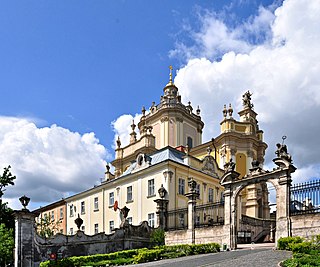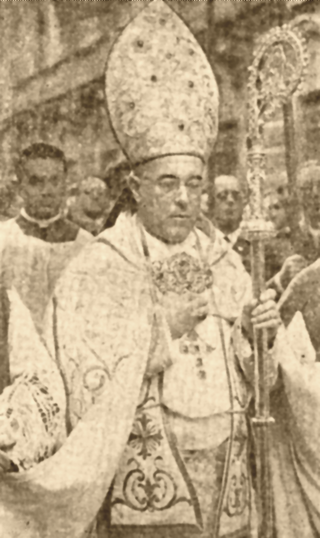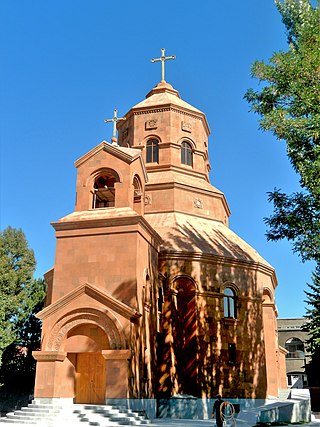
The Eastern Catholic Churches or Oriental Catholic Churches, also called the Eastern-Rite Catholic Churches, Eastern Rite Catholicism, or simply the Eastern Churches, are 23 Eastern Christian autonomous particular churches of the Catholic Church, in full communion with the Pope in Rome. Although they are distinct theologically, liturgically, and historically from the Latin Church, they are all in full communion with it and with each other. Eastern Catholics are a distinct minority within the Catholic Church; of the 1.3 billion Catholics in communion with the Pope, approximately 18 million are members of the eastern churches.

The Ukrainian Greek Catholic Church (UGCC) is a major archiepiscopal sui iuris ("autonomous") Eastern Catholic church that is based in Ukraine. As a particular church of the Catholic Church, it is in full communion with the Holy See. It is the second-largest particular church in the Catholic Church after the Latin Church. The major archbishop presides over the entire Church but is not distinguished with the patriarchal title. The incumbent Major Archbishop is Sviatoslav Shevchuk.

The Ruthenian Greek Catholic Church, also known in the United States as the Byzantine Catholic Church, is a sui iuris (autonomous) Eastern Catholic church based in Eastern Europe and North America. As a particular church of the Catholic Church, it is in full communion with the Holy See. It uses the Byzantine Rite for its liturgies, laws, and cultural identity.

The Priestly Society of Saint Josaphat Kuntsevych (SSJK) is a society of traditionalist priests and seminarians originating from the Ukrainian Greek Catholic Church which is led by the excommunicated priest Basil Kovpak. It is based in Riasne, Lviv, Western Ukraine. In Lviv, the society maintains a seminary, at which currently thirty students reside, and takes care of a small convent of Basilian sisters. The SSJK is affiliated with the Society of St. Pius X and Holy Orders are conferred by the latter society's bishops in the Roman Rite. The SSJK clergymen, however, exclusively follow a version of Slavonic Byzantine Rite in the Ruthenian recension.
Nicholas Thomas Elko was an American Ruthenian Greek Catholic and the third bishop of the Byzantine Catholic Metropolitan Church of Pittsburgh. At the age of 46 he became the first American-born bishop of the Ruthenian Greek Catholic Church. He later served as Auxiliary Bishop of the Archdiocese of Cincinnati, a Latin Church archdiocese.
Stephen John Kocisko was the first Metropolitan Archbishop of the Byzantine Catholic Metropolitan Church of Pittsburgh, the American branch of the Ruthenian Greek Catholic Church

The Archeparchy of Pittsburgh is an archeparchy of the Ruthenian Greek Catholic Church that is located in the southern part of the United States of America. It is part of the Metropolis of Pittsburgh. The geographical remit of the archeparchy includes the states of Alabama, Arkansas, Kentucky, Louisiana, Mississippi, Pennsylvania, Tennessee, Texas, and West Virginia. The incumbent archeparch is the Most Reverend William C. Skurla. The episcopal seat is situated in the city of Pittsburgh.
Orientales omnes Ecclesias is an encyclical of Pope Pius XII to the faithful of the Ukrainian Greek Catholic Church. It commemorates the three hundred and fiftieth anniversary of the Union of Brest.

Michael Levytsky ; 17 February, 1774 – 14 January, 1858) was the Metropolitan Archbishop of the Ukrainian Greek Catholic Church from 1816 until his death in 1858 and a Cardinal of the Catholic Church. He was from a Ukrainian Greek Catholic sacerdotal family and nobility with the herbu, de Rogale.
A particular church is an ecclesiastical community of followers headed by a bishop, as defined by Catholic canon law and ecclesiology. A liturgical rite, a collection of liturgies descending from shared historic or regional context, depends on the particular church the bishop belongs to. Thus the term "particular church" refers to an institution, and "liturgical rite" to its ritual practices.

The Ordinariate of Brazil for the faithful of the Eastern rite or Brazil of the Eastern Rite is an ordinariate for the Eastern Catholics in Brazil without proper jurisdiction of their own particular churches sui iuris.

The Armenian Catholic Ordinariate of Eastern Europe is an Ordinariate (quasi-diocese) of the Armenian Catholic Church for its faithful in certain Eastern European ex-Soviet countries without proper Ordinary for their particular church sui iuris.

The Ordinariate for the Faithful of Eastern Rite in Spain is an Ordinariate (pseudo-diocese) for all non-Latin Catholic faithful living in Spain who belong to the particular Churches sui iuris of any Eastern rite immediately subject to the Holy See.
The Ordinariate for Eastern Catholics in Argentina is a Catholic Ordinariate for Eastern Catholic faithful, jointly for all Eastern Catholics, regardless of rite, living in Argentina.

The Ordinariate for Eastern (Rite) Catholics in France is a Catholic Ordinariate for Eastern Catholic faithful, jointly for Eastern Catholics in various rites and languages of particular churches sui iuris without proper jurisdiction there.

The Ordinariate for Eastern Catholics in Poland is the Ordinariate for Eastern Catholic faithful for the members of Eastern Catholic particular churches sui iuris in Poland, excepting Ukrainian Greek Catholic Church, which has its own local ordinaries.
Greek Catholic Church may refer to:

The Chapel of St. Roch is a Catholic chapel in Penzing at Penzinger Street 70, Austria. The chapel is dedicated to the two plague saints, Roch and Sebastian.













